Russia’s Lancet loitering munition has demonstrated a new level of autonomy in target identification, suggesting a shift towards more AI-enabled warfare capabilities.
The Lancet, a 25-pound drone capable of destroying tanks, artillery, and other vehicles from up to 30 miles away, has been observed displaying vehicle names on its targeting display instead of the generic ‘target lock’ indicator. This change suggests an automated object identification system is at work, possibly enhancing the drone’s ability to select and engage targets without direct human intervention.
This advancement comes after previous versions of the Lancet showed limitations in target selection, including an incident where the drone shifted its lock from a vehicle to a pile of debris. ZALA, the manufacturer of the Lancet, appears to have refined the drone’s capabilities, allowing for more precise target identification. This includes the ability to distinguish between different types of military vehicles, such as the 2S1 Gvozdika self-propelled gun and the Leopard 2 tank, among others. However, the Lancet’s operation still involves initial spotting by scout drones, with the kamikaze drone being vectored onto the target for terminal guidance.
Expanded Coverage:






